The USEF needs professional “test writers.”…people who validate whether tests actually can quantify or measure whether the test instrument accurately measures to some standard (the rule book).
The “meanings” of the scores are there in the rulebook
10 Excellent
9 Very Good
8 Good
7 Fairly Good
6 Satisfactory
5 Marginal
4 Insufficient
3 Fairly Bad
2 Bad
1 Very Bad
0 Not executed
This ranking is called a “Likert Scale.”
The USDF/USEF (dressage committee is populated by same people) who changed a score of 5 (Used to be Sufficient, which is still used by FEI) to be defined by “Marginal.” This really adds to the confusion.
Even when I go to the dictionary, it doesn’t clarify things…
Of the many definitions of “marginal…
“close to the lower limit of qualification, acceptability, or function"…or
“barely exceeding the minimum requirements.”*
I have audited 3 L-Judges training, riding in one as a demo rider for 2nd Level. I found it interesting that in the videos used in the instruction, there were few (may no) examples of how to use the low scores. There did not seem to be any videos of riding that merited 0, 1, 2, 3…there might have been a few examples providing discussion of movements meriting a 4…but only in the discussions of “Is it a 4 or a 5?” I don’t recall any examples of “this is clearly a 1, 2, 3” for movements illustrated in vids.
If the judges are not educated on the use of the full grading scale to clearly understand what riding constitutes meriting scores in the lower half of the scales, then we have " score compression"…eg, the scores are all clustered around 5-6-7-8…and thus the current need for “half-points.”
This is not new news to anyone who studies measurement systems and who does "MSA’s -Measurement System Analysis- professionally…as I did for at least 15 years.
Also, in measurement theory, these scales are considered “linear”…eg., there is the same “spacing” between the numbers.
The way it SHOULD BE
0…1…2…3…4…5…6…7…8…9…10
As I see the dressage scoring scale currently applied, the scale is extremely NON-linear…eg:
The way IT IS NOW…something like this
0–1--2–3-----4------5--------6------7-----------8-------------9---------------------------10
Edited for formatting to show non-linearity



